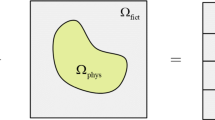Abstract
It has been demonstrated recently that the absolute nodal coordinate formulation (ANCF) can be used to develop lower-order consistent rotation-based formulations (CRBFs) that employ finite rotation parameters as nodal coordinates without the need for interpolating the rotation field. The objective of this study is to develop new planar shear deformable ANCF/CRBF beam elements and demonstrate their use. A cubic ANCF/CRBF shear deformable beam element is first developed starting with the ANCF kinematic description that employs position vector gradients as nodal coordinates. The transverse position vector gradients at the nodes are expressed in terms of finite rotation parameters, leading to a lower-dimensional beam element model that captures the shear deformation, ensures continuity of the stresses and rotations at the nodes, allows for an arbitrary large displacement, and has a kinematic description consistent with geometry methods and suitable for systematically modeling curved structures. The results, obtained using the new planar ANCF/CRBF shear deformable beam element, are compared with the original and more general ANCF shear deformable beam element. Another lower-dimension bilinear CRBF beam element which has three coordinates at each node, two translation coordinates and one rotation parameter, is also developed in this investigation. The formulations of the three finite elements, including the ANCF finite element, considered in this investigation are compared. Numerical results are presented in order to demonstrate the use of the new formulations and test their performances in the analysis of large displacements and deformations. While the ANCF/CRBF assumptions are evaluated numerically, the results obtained show, in general, a good agreement between the elements considered in this study. The results also show that the CRBF finite elements, which have nonlinear mass matrix, can be more efficient for smaller meshes. As the mesh size and the number of finite elements increase, the original higher-order ANCF finite elements, which have constant mass matrix and zero Coriolis and centrifugal forces, become more efficient. The ANCF/CRBF approach clearly demonstrates that there is no need for introducing an independent rotation field to capture the shear effect.















Similar content being viewed by others
References
Simo, J.C., Vu-Quoc, L.: On the dynamics of flexible beams under large overall motions—the plane case: Parts I and II. ASME J. Appl. Mech. 53, 849–863 (1986)
Ding, J., Wallin, M., Wei, C., Recuero, A.M., Shabana, A.A.: Use of independent rotation field in the large displacement analysis of beams. Nonlinear Dyn. 76, 1829–1843 (2014)
Goldstein, H.: Classical Mechanics, 1st edn. Addison Wesley, Boston (1950)
Roberson, R.E., Schwertassek, R.: Dynamics of Multibody Systems. Springer, Berlin (1988)
Shabana, A.A.: Computational Dynamics, 3rd edn. Wiley, New York (2010)
Antman, S.S.: The theory of rods. In: Handbuch der Physics, vol. VIa/2, pp. 641–703. Springer, Berlin (1972)
Antman, S.S.: Kirchhoff’s problem for nonlinearly elastic rods. Q. Appl. Math. 32, 221–240 (1974)
Reissner, E.: On a one dimensional finite strain beam: the plane problem. J. Appl. Math. Phys. 23, 795–804 (1972)
Reissner, E.: On a one dimensional large-displacement, finite strain beam theory. Stud. Appl. Math. 52, 87–95 (1973)
Reissner, E.: On finite deformations of space-curved beams. J. Appl. Math. Phys. (ZAMP) 32, 734–744 (1981)
Nachbagauer, K.: Development of shear and cross section deformable beam finite elements applied to large deformation and dynamics problems. Ph.D. dissertation, Johannes Kepler University, Linz, Austria (2013)
Omar, M.A., Shabana, A.A.: A Two-dimensional shear deformable beam for large rotation and deformation problems. J. Sound Vib. 243, 565–576 (2001)
Dmitrochenko, O., Mikkola, A.: Digital nomenclature code for topology and kinematics of finite elements based on the absolute nodal co-ordinate formulation. IMechE J. Multibody Dyn. 225, 34–51 (2011)
Hamed, A.M., Jayakumar, P., Letherwood, M.D., Gorsich, D.J., Recuero, A.M., Shabana, A.A.: Ideal compliant joints and integration of computer aided design and analysis. ASME J. Comput. Nonlinear Dyn. 10, 021015-1–021015-14 (2015)
Hu, W., Tian, Q., Hu, H.Y.: Dynamics simulation of the liquid-filled flexible multibody system via the absolute nodal coordinate formulation and SPH method. Nonlinear Dyn. 75, 653–671 (2014)
Khan, I.M., Anderson, K.S.: Divide-and-conquer-based large deformation formulations for multi-flexible body systems. In: ASME 9th International Conference on Multibody Systems, Nonlinear Dynamics, and Control, vol. 7B, pp. V07BT10A002-1–V07BT10A002-10 (2013)
Laflin, J.J., Anderson, K.S., Khan, I.M., Poursina, M.: New and extended applications of the divide-and-conquer algorithm for multibody dynamics. J. Comput. Nonlinear Dyn. 9, 041004-1–041004-8 (2014)
Liu, C., Tian, Q., Hu, H.Y.: Dynamics of large scale rigid–flexible multibody system composed of composite laminated plates. Multibody Syst. Dyn. 26, 283–305 (2011)
Orzechowski, G.: Analysis of beam elements of circular cross section using the absolute nodal coordinate formulation. Arch. Mech. Eng. 59, 283–296 (2012)
Orzechowski, G., Frączek, J.: Integration of the equations of motion of multibody systems using absolute nodal coordinate formulation. Acta Mech. Autom. 6, 75–83 (2012)
Orzechowski, G., Frączek, J.: Nearly incompressible nonlinear material models in the large deformation analysis of beams using ANCF. Nonlinear Dyn. 82, 1–14 (2015)
Shabana, A.A.: Computational Continuum Mechanics, 2nd edn. Cambridge University Press, Cambridge (2012)
Shabana, A.A.: ANCF tire assembly model for multibody system applications. ASME J. Comput. Nonlinear Dyn. 10, 024504-1–024504-4 (2015)
Tian, Q., Chen, L.P., Zhang, Y.Q., Yang, J.Z.: An efficient hybrid method for multibody dynamics simulation based on absolute nodal coordinate formulation. ASME J. Comput. Nonlinear Dyn. 4, 021009-1–021009-14 (2009)
Tian, Q., Sun, Y.L., Liu, C., Hu, H.Y., Paulo, F.: Elasto-hydro-dynamic lubricated cylindrical joints for rigid–flexible multibody dynamics. Comput. Struct. 114–115, 106–120 (2013)
Shabana, A.A.: ANCF consistent rotation-based finite element formulation. ASME J. Comput. Nonlinear Dyn. 11, 014502-1–014502-4 (2016)
Author information
Authors and Affiliations
Corresponding author
Rights and permissions
About this article
Cite this article
Zheng, Y., Shabana, A.A. A two-dimensional shear deformable ANCF consistent rotation-based formulation beam element. Nonlinear Dyn 87, 1031–1043 (2017). https://doi.org/10.1007/s11071-016-3095-4
Received:
Accepted:
Published:
Issue Date:
DOI: https://doi.org/10.1007/s11071-016-3095-4




